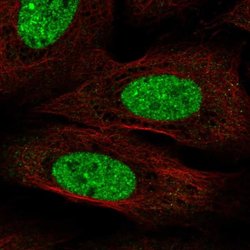Promotional price valid on web orders only. Your contract pricing may differ. Interested in signing up for a dedicated account number?
Learn More
Learn More
Invitrogen™ CPEB3 Polyclonal Antibody
Rabbit Polyclonal Antibody
Supplier: Invitrogen™ PA566232
Description
Immunogen sequence: FNLHSLENSLM DMIRTDHEPL KGKHYPPSGP PMSFADIMWR NHFAGRMGIN FHHPGTDNIM ALNSRSSLFP FEDAFLDDSH GDQ Highest antigen sequence identity to the following orthologs - mouse 100%, rat 65%.
Sequence-specific RNA-binding protein which acts as a translational repressor in the basal unstimulated state but, following neuronal stimulation, acts as a translational activator. In contrast to CPEB1, does not bind to the cytoplasmic polyadenylation element (CPE), a uridine-rich sequence element within the mRNA 3'-UTR, but binds to a U-rich loop within a stem-loop structure. Required for the consolidation and maintenance of hippocampal-based long term memory. In the basal state, binds to the mRNA 3'-UTR of the glutamate receptors GRIA2/GLUR2 mRNA and negatively regulates their translation. Also represses the translation of DLG4, GRIN1, GRIN2A and GRIN2B. When activated, acts as a translational activator of GRIA1 and GRIA2. In the basal state, suppresses SUMO2 translation but activates it following neuronal stimulation. Binds to the 3'-UTR of TRPV1 mRNA and represses TRPV1 translation which is required to maintain normal thermoception. Binds actin mRNA, leading to actin translational repression in the basal state and to translational activation following neuronal stimulation. Negatively regulates target mRNA levels by binding to TOB1 which recruits CNOT7/CAF1 to a ternary complex and this leads to target mRNA deadenylation and decay (PubMed:21336257). In addition to its role in translation, binds to and inhibits the transcriptional activation activity of STAT5B without affecting its dimerization or DNA-binding activity. This, in turn, represses transcription of the STAT5B target gene EGFR which has been shown to play a role in enhancing learning and memory performance (PubMed:20639532). In contrast to CPEB1, CPEB2 and CPEB4, not required for cell cycle progression (PubMed:26398195). [UniProt].
Specifications
| CPEB3 | |
| Polyclonal | |
| Unconjugated | |
| Cpeb3 | |
| 4831444O18Rik; CPEB3; CPE-binding protein 3; CPE-BP3; cytoplasmic polyadenylation element binding protein 3; cytoplasmic polyadenylation element-binding protein 3; hCPEB-3; KIAA0940; mKIAA0940; RGD1564670 | |
| Rabbit | |
| Antigen Affinity Chromatography | |
| RUO | |
| 22849 | |
| Store at 4°C short term. For long term storage, store at -20°C, avoiding freeze/thaw cycles. | |
| Liquid |
| Immunocytochemistry | |
| 0.3 mg/mL | |
| PBS with 40% glycerol and 0.02% sodium azide; pH 7.2 | |
| Q8NE35 | |
| Cpeb3 | |
| Recombinant Human CPEB3. Recombinant protein control fragment (Product #RP-106911). | |
| 100 μL | |
| Primary | |
| Human | |
| Antibody | |
| IgG |
Safety and Handling
WARNING: Cancer - www.P65Warnings.ca.gov
Product Content Correction
Your input is important to us. Please complete this form to provide feedback related to the content on this product.
Product Title
Spot an opportunity for improvement?Share a Content Correction
